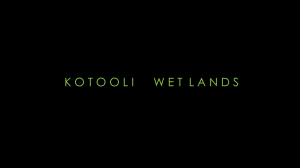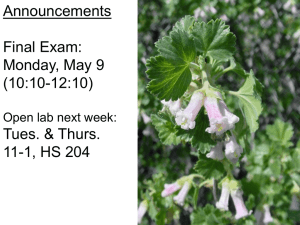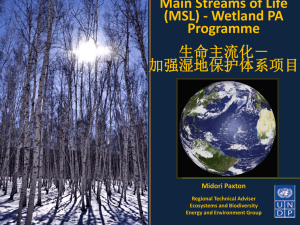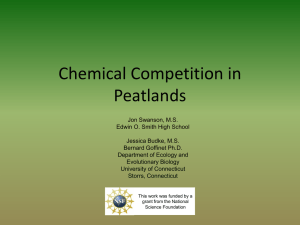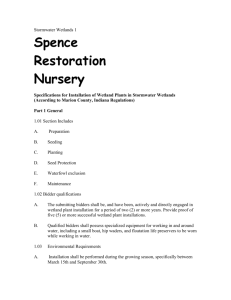Georgia Biodiversity - Interpretative Trails on the Ground
advertisement
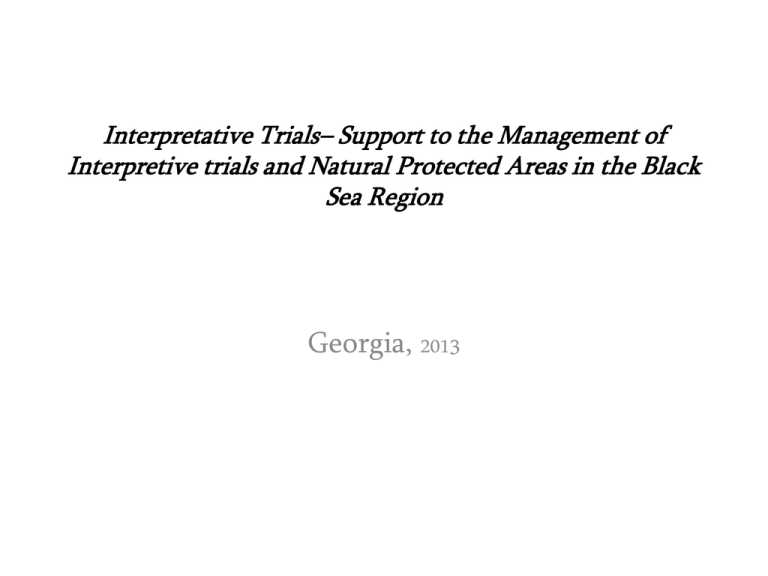
Interpretative Trials– Support to the Management of Interpretive trials and Natural Protected Areas in the Black Sea Region Georgia, 2013 Protected Areas • In Georgia the history of Protected Areas dates back many centuries. The first Protected Area – Lagodekhi Strict Nature Reserve was established as early as 1912. At present the total area of Protected Areas is 520 273 hectares, which is about 7.46 % of the country’s territory. About 75 % of Protected Areas are covered by forests. • Primary function of the Protected Areas is protection of natural heritage of the country, unique biodiversity and eco systems. • In Georgia there are 64 different categories of Protected Areas according the IUCN: – – – – – 14 Strict Nature Reserves 10 National Parks 18 Managed Nature Reserves 24 Natural Monuments 2 Protected Landscapes Biodiversity • Kolkheti National Park Trial Sea Route Paliastomi – Pichori • Kobuleti Protected Areas Trial Trip to the oldest wetland • Mtirala National Park Trial Fairy Mtirala Mount • Kintrishi protected Areas Trial Legends of Colchic Forest Kolkheti National Park • National Park is located in western Georgia. It covers the eastern zone of the Black Sea coast and the basin of the Paliastomi Lake. The Park is established with the purpose of protection and saving wetland ecosystems. • The Kolkheti lowland became the subject of international interest firstly in 1996, when the Georgia joined the Ramsar Convention on “Wetlands of International Importance Especially as Waterfowl Habitat”. Since 2000 the Kolkheti national park began full-scale functioning. In total, the land area of the National Park is 28571 hectares, and the sea water area – 15 742 hectares. The real beauty of the Kolkheti national park is the Paliastomi Lake that was the gulf of the Black Sea several thousand years ago. Kolkheti National Park Trial Sea Route Paliastomi – Pichori • Kolkheti wetlands are featured with domed surface and tussocks, which are formed by sphagnum mosses. • In Kolkheti wetland grow following Boreal species ( native for tundra and taiga) as: Sphagnum mosses (Spagnum imbricatum, Sp. palustre, Sp. acutiflium), roundleaved sundew (Drosera rotundiflora), white beak sedge (Rhynhospora alba), woolly fruit sedge (Carex lasiocarpa) marsh trefoil (Menianthes trifoliata). • In Kolkheti wetland grow sedge(Carex acutifolium, C. vesicaria and etc.), rush (Juncus effusus, J. infexus, J. acutus and etc.), reed mace Typha latifolia, T. angustifolia), common reed (Phragmites australis), yellow iris ( Iris pseudacorus), Imeretian sedge (Molinia litoralis), Royal fern (Osmunda regalis), golden rod (Solidago turfosa), seashore mallow (Kosteletzkya pentacarpos) and others. Such species of mountainous Kolkhic flora as are azalea (Rhododendron luteum) and rhododendron (R. ponticum) add originality to Kolkheti peaty mires. Alder tree and Sedge 1. Natural tributaries to Pichori river ; 2. Water lily (paneralium maritimum) at rocky coastal dune 1. White lily (Nympaea colchica), Pichori river 2. Dalmatian pelicans (Palecanus crispus), Paliastomi Lake Fauna Fauna of the park is its’ the most important shelter. While the exact place of species habitation isn’t defined yet. Birds (Aves) The swamps and wetland forests of the park , rivers and lakes of the Park provide wintering and resting place for 194 bird species. Some of them are migrating species. According to CMS or Bonn Convention and AfricanEurasian Waterbird (AEWA) protected bird species are: Dalmatinan pelican (Pelicanus crispus), Common crane ( Grus grus), Black Storke (Ciconia nigra), Little Heron ( Egretta garzetta) et al. Ichthyofauna For such a rare species as is Atlantic sturgeon (Acipenser sturio) mentioned in IUCN- Red List, over the last ten years was disseminated only in Rioni river. Kobuleti Protected Areas Trial - Trip to the oldest wetland The Kobuleti Protected Areas were established in 1999 and cover the Kobuleti Strict Nature Reserve (331 ha) and Kobuleti Managed Nature Reserve (439 hectare), which are located along the Black Sea coast in the northern part of Kobuleti. Importance of Ispani mires • The Protected Areas are distinguished with species of migrating waterfowls. Though, these places are very rich in plant species. At present there are partly degraded secondary plant communities in the IspaniI. Ispani-II (Kobuleti Managed Nature Reserve) is a unique percolation dome-like mire of world importance that only feeds on rain water. The whole background for the peat mire of Kobuleti Protected Areas is covered with peat mosses – sphagnum species, such as white beak sedge (Rhynchospora alba), Imeretian sedge (Molinia litoralis) buckbean (Menyanthes trifoliata) and round-leaved sundew (Drosera rotundiflora), et al. Sphagnum 1. Wetland Sedge 2. Round-leaved sundew in Ispani peat bog Mtirala National Park • Significant part of the National Park territory ( ex Ciskara Nature Reserve) till 1960th in quite good condition. It should be noted, that almost all territory of the National Park is covered with forest and shrubs. Colchic vegetation is unique in the entire world – it is represented only in western part of the Black Sea area (ancient Kolchida). Uniqueness is stipulated by the fact that during the Ice Age Kolkheti provided shelter for tertiary relict plants some of them could be found here even now. Area of National Park is featured with typical Colchic vegetation, particularly with shrubbery. • Park creates wide opportunities for successful tourism development. At present Mtirala National Park is the only one protected area, which provides basement for bonding costal and mountain tourism. Trail – Fairy Mtirala Mountain • Mtirala flora is abundant and diversified. In National park is distributed chestnut, beech and Colchic mixed forest. For Kolkheti is distinctive Rhododendron shrubbery . In Colchic forest one can find beech, lime, chestnut, alder trees, hornbeam. The subforest is covered with cherry laurel shrubs, Colchic box tree and several kinds of lianas . The first tourist trials bases from the visitor center at Mtirala National Park. The trail is going across the left bank of the river Chakvistavi. Its height is from 296 m to 476m. While passing the trail one can see species of Colchic flora and fauna: Georgian walnut listed in the Red Book, Colchis nut, Rhododendron; brown bear, marten, fox; eagle, hawk, blackbird and pigeon . Relict beeches Kintrishi Protected Areas Trial Legends of Colchic Forest • Kintrishi Protected Areas consist of Kintrishi Strict Nature Reserve, founded in 1958 and and Kintrishi Protected landscape, created in 2007. Kintrishi Protected Areas are situated in Kobuleti district of Adjara, at 360 km distance from Tbilisi in the Kintrishi river gorge between the village of Tskhemlovani and mount Khino. Lower border of Kintrishi Protected Areas stretches at 250300 m above sea level, and the upper one borders on Alpine pastures. Five hundred years old Yew tree • Kintrishi Protected Areas are characterized not only with variaty of relict elements of Colchic flora, but also by their speculiarities. Here you can find Pontic rhododendron, box tree, Cherry laurel of 20 meter height. Evegreen yew trees, beeces, chestnuts, limes and enwrapping them Colchic ivy. Fauna • Is widely presenetd by • In Kintrishi Protected Area there animals and birds. Bear, are numerous rivers and streams wolf, lynx, deer, chamois, rich in trout. Kintrishi river is one hare, badger, marten, fox, of Georgian rivers , whci provides squirrel, wild boar. Upper nesting place for sulmons. slopes of mount are • In gorg ecan be founs Caucasus inhabited by egale, salamande and newt. endemic species for Lesser • Salamander is commnon in villag Caucasus - snowcock. eof Tsarakvetsa while newt in Fauna abounds following Tbikeli Lake . fish species: trout, mullet and amphibias: banded newt and Caucasian salamander. Kintrishi river and its surroundings Thank you !





